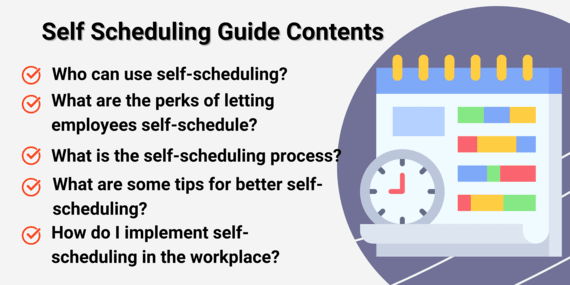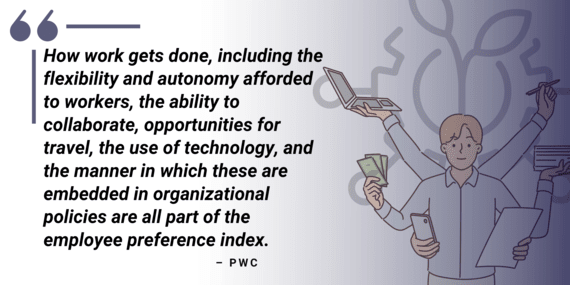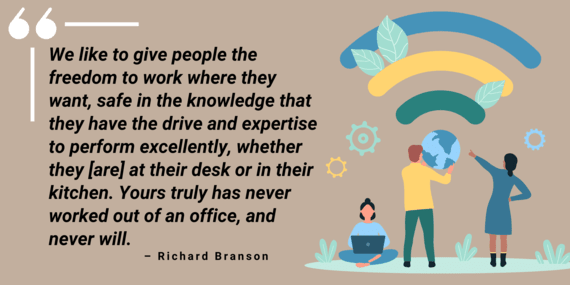
A Complete Guide To Employee Self-Scheduling
Self-scheduling involves allowing employees to choose their shifts or exchange shifts (or shift work) with teammates. A manager still has a portion of control over schedules, but it helps reduce some of their responsibilities. It has many advantages, and it will be ideal for your business.
Employees will also enjoy creating part of their schedules.

Continue reading to find answers to the following self-scheduling questions.

Who Can Use Self-Scheduling?
Almost any industry can use self-scheduling.
Companies that rely on it the most often have employees from multiple countries or employees who plan to work overseas.

Source: Finder
It’s helpful for employees and employers.
For businesses that work on-site, you can still self-schedule. No matter the shifts you apply in your business, you can still integrate it into various industries.
Perks of Letting Employees Choose Their Schedule
Self-scheduling has many advantages for employees and employers.
It primarily benefits employees, so many more are using it. In a study from the Australian Bureau of Statistics, 36% of employees (in August 2021) had a flexible work agreement; it was 34% in 2019. Flexible working arrangements usually include employees being able to self-schedule for working hours and vacation days.
Here are some benefits of using self-scheduling in your company.
It Gives Employees More Flexibility to Have a Work-Life Balance 👯
Self-scheduling helps improve flexibility for employers and employees.
The more flexible scheduling system (than traditional scheduling) provides maximum flexibility in the business operation regarding demand and needed shifts for employers.
For employees, it helps them maintain a work-life balance. It also gives them time for their other commitments. Doing this will make them happier and reduce stress and burnout.

Source: PWC
Reduced Absences 🙋
Employees may miss work for the following reasons:
- Emergencies.
- Sickness.
- Harsh weather.
- Conflicts.
Due to self-scheduling, employees can trade shifts with each other or choose an alternative schedule if they cannot work on a specific date. If all employees have this mindset, you can reduce work absences.
Great for Recruitment and Retention
During recruitment, you can inform the potential recruit about the company’s scheduling options and policies. Offering self-scheduling can be advantageous for your company because it can be a big reason they will choose to work for you.
It is also ideal for employee retention because they typically prefer a company that offers flexible scheduling. After all, it gives them more freedom and a better work-life balance.
Improved Productivity
Self-scheduling can increase productivity because the employees may choose the schedule that best suits them.
Happiness during work can significantly enhance productivity. In a study about Australian worker happiness, 27% of workers said that a lack of control over schedules and workload is why they are unhappy at work.
Less Involvement from Managers
Because of self-scheduling, the manager or the person who usually makes the schedule will have less participation. Therefore, they can focus on other tasks they need to finish.
Initially, they need to train other employees on how to create their employee schedule. But after time, team members can do it on their own. The manager just needs to review and finalize the schedule.
It Saves Time ⏳
Managers can have difficulty creating a schedule because they must consider many factors, like customers’ demands, availability, and other commitments.
Due to self-scheduling, it’s quicker and easier for managers to finalize the schedule. The reason for this is that the employees take note of their availability, obligations, and other factors and add them to the schedule in real time.
Self-Scheduling Process
Self-scheduling might seem daunting, but once you get the flow of it, you’ll find it relatively easy.
Here are some steps for using self-scheduling for your company.
1. Establish Guidelines
Like other tasks, you must provide guidelines for the self-scheduling process.

Doing this varies on what type of business you have. An example of a rule is the limit of a particular employee’s working hours.
2. Make a Template
After informing everyone about the guidelines, you should create a schedule template.
Ensure that you mention the shifts that you require employees to fill.
3. Set Beginning and Final Dates 📅
Make it clear to your employees when they can start scheduling and the last day for scheduling time. Also, inform them that they can create their schedule on a mobile device.
That way, you can easily finalize the schedule after everyone chooses their availability.
4. Share the Template
After informing your employees about the start and end dates, share the template you created so they can fill it up.
5. Finalize and Distribute
After the end date of the scheduling period, finalize the schedule.

For the next schedule batches, you can repeat the process and skip out the steps you think are unnecessary.
Tips for Better Self-Scheduling
If it’s the first time your company will use self-scheduling, here are some tips to help you transition.
Inform Everyone

You should tell all your employees that you are implementing a self-scheduling method. Inform them about its benefits and how to do it. Show them the guidelines you want them to follow, the beginning and final dates, and the template.
Ask your employees about their opinions, questions, and concerns. Tell them that you can help them with scheduling if they need any assistance.
Be Positive 🧏
Some people are not entirely accepting of changes to the scheduling process.
The established staff must be optimistic about new self-scheduling initiatives and communicate them positively to other employees.
All other employees will welcome this change if this happens.

Source: shawnachor.com
Should You Have Concerns About Self-Scheduling?
Although self-scheduling has many benefits, you may still have concerns. We will address the concerns and show you that they aren’t as big of a red flag as you may think.
A common concern is that you cannot fairly distribute shifts. For example, when two employees want a day off on the same day, and they both schedule it, but you may still need one of them to work.
To avoid problems like this, you need to encourage employees to communicate with each other. If the two employees knew they wanted the same day off before scheduling, one of them may be willing to compromise.
Another concern you may have is that some employees may clock in hours but not do any work. To spot and stop this problem, you should employ monitoring during the first few weeks of the implementation process.
Doing this will help you find employees taking advantage of the scheduling system.
Our Final Thoughts on Why You Should Get Employees to Use Self-scheduling
Self-scheduling benefits managers and staff. It is simple to use, and you can integrate it into various types of businesses.
It can help employees because it can:
- Introduce more flexibility into their working lives.
- Improve their productivity.
- Save them and you time.
Also, self-scheduling eliminates the need for you to create employee schedules; this means you can complete other crucial tasks while employees create their schedules.
To ensure the scheduling process is successful, inform everyone in the company how to do it and finalize and distribute every schedule.

If you want to start using self-scheduling, take a look at our tool on Tommy.
- A Complete Guide To Employee Self-Scheduling
- Who Can Use Self-Scheduling
- Perks Of Letting Employees Choose Their Schedule
- It Gives Employees More Flexibility To Have A Work-Life Balance
- Great For Recruitment And Retention
- Improved Productivity
- Less Involvement From Managers
- It Saves Time
- Self-Scheduling Process
- 1. Establish Guidelines
- 2. Make A Template
- 3. Set Beginning And Final Dates
- 4. Share The Template
- 5. Finalize And Distribute
- Tips For Better Self-Scheduling
- Inform Everyone
- Be Positive
- Should You Have Concerns About Self-Scheduling?
- Our Final Thoughts On Why You Should Get Employees To Use Self-Scheduling





